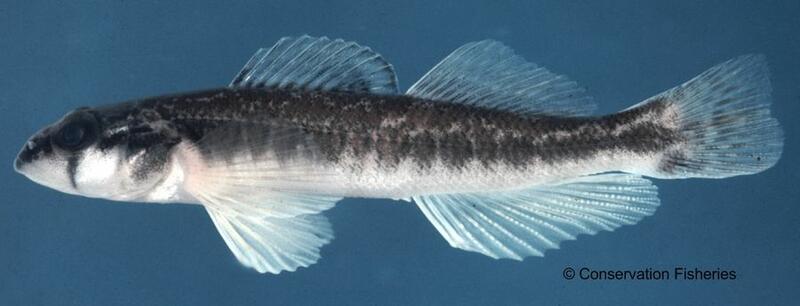







Loading profile. Please wait . . .
Percina shumardi (Girard, 1859)
River Darter




Federal Protection: No US federal protection
State Protection: Endangered
Global Rank: G5
State Rank: SX
Element Locations Tracked in Biotics: Yes
SWAP 2015 Species of Greatest Conservation Need (SGCN): No
SWAP 2025 Species of Greatest Conservation Need (SGCN): No
2025 SGCN Priority Tier: None
Element Occurrences (EOs) in Georgia: 1
Habitat Summary for element in Georgia: Large to medium rivers, deep chutes and riffles, coarse gravel substrate
This medium-sized darter, reaching up to 90 mm (3.5 in) total length, is marked by 8-15 elongated blotches along its side, a mottled back with 5-9 ill-defined dorsal saddles, a small caudal spot, and a black teardrop beneath each eye. The dorsum and sides are dusky or gray and the venter is pale. There are black spots on the anterior and posterior portions of the first dorsal fin. Breeding males have an elongated anal fin and develop tubercles on the anal, caudal and pelvic fins, as well as on the venter. They may also have blue-green iridescent markings along the lateral blotches and on the head; breeding males from the Alabama River system also have an orange submarginal band in the first dorsal fin.
The river darter is a close relative of the amber darter (Percina antesella) and both species occur within the mainstem Conasauga River in Georgia and Tennessee. These species have similar body shapes, males with elongated anal fin rays, and prominent sub-orbital bars. However, the amber darter differs in having four prominent dorsal saddles (vs 5-9 weakly defined saddles in the river darter).
River darters are found in larger streams where they inhabit riffles and runs with swift currents and rock to sand substrates, including chutes over about 1 m (3 ft) deep. The river darter displays some tolerance to turbidity and may also survive in the fluctuating waters downstream from hydroelectric dams.
Macroinvertebrates including midges, mayflies, caddisflies, and snails.
The river darter spawns from February to May in fastwater habitat. The newly hatched larvae may drift downstream, probably to pool and stream margin habitats. As they grow, the young darters shift into faster water. Life span is probably 2-4 years.
This species is difficult to collect by virtue of its occurrence in deep and swift habitats. Targeted seining during low flow periods and droughts has been effective in Mississippi. The river darter may move into shallow habitats at night, suggesting that night-seining may increase the odds of capture.
The river darter ranges from the Hudson Bay drainage in Manitoba and western Ontario south to the Mississippi River drainage and the Gulf Coast, where it occurs from Texas to the Mobile River basin. In the Mobile Basin, the river darter only commonly occurs below the Fall Line (for example, in the lower Tallapoosa River, the Alabama River, and in the lower Cahaba River), with more scattered occurrences in the Coosa and Black Warrior river systems. In Georgia, the river darter is known only from the Conasauga River at the Tennessee-Georgia state line (Murray County). Fewer than five specimens have been taken at this locality, these collected over a period of several years after 1969. Check the [Fishes of Georgia Webpage](http://fishesofgeorgia.uga.edu/index.php?page=speciespages/species_page&key=percshum) for a watershed-level distribution map.
The river darter is exceptionally rare in Georgia. The Georgia and southeastern Tennessee population in the Conasauga River represents an isolated population in the upper Coosa River system. The river darter could be extirpated from Georgia by habitat destruction in the upper Conasauga River. Of specific concern are increased siltation and use of agricultural chemicals, impoundment, and general degradation of riffle habitat.
This species has not been collected in the Conasauga River system since 1972 and may be extirpated.
Conserving the river darter in Georgia depends on maintaining habitat quality in the less-impacted upstream portion of the Conasauga River, and ultimately on improving habitat and water quality in the lower part of the river. It is essential to eliminate sediment runoff from land-disturbing activities, such as roadway and housing construction, as well as inputs of contaminants such as fertilizers and pesticides. [Forested buffers](https://www.tva.gov/Environment/Environmental-Stewardship/Land-Management/Shoreline-Stabilization) should be maintained along the banks of the river and the smaller tributary streams that feed the river. Maintaining natural streamflow patterns by preventing excessive water withdrawal or unnaturally flashy runoff (such as from urban stormwater runoff) is also an essential element of protecting riverine habitat quality. The river darter and other fishes that similarly depend on riffle and run habitats are especially vulnerable to streamflow depletion, because habitats with swift currents are diminished at low flows.
Boschung, H.T. and R.L. Mayden. 2004. Fishes of Alabama. Smithsonian Books, Washington, DC. 736 pp.
Etnier, D. A. and W.C. Starnes. 1993. The fishes of Tennessee. Univ. Tennessee Press, Knoxville. 681pp.
Lee, S. L., C. R. Gilbert, C. H. Hocutt, R. E. Jenkins, D. E. McAllister, and J. R.Stauffer. 1980. Atlas of North American fishes. North Carolina State Mus. Nat. Hist. 867pp.
Mettee, M. F., P. E. O'Neil and J. M. Pierson. 1996. Fishes of Alabama and the Mobile Basin. Oxmoor House, Birmingham. 820pp.
Page, L. M. and B. M. Burr. 1991. A field guide to freshwater fishes of North America north of Mexico. Houghton Mifflin, Boston. 432pp.
Pierson, J. M., W. M. Howell, R. A. Stiles, M. F. Mettee, P. E. O'Neil, R. D. Suttkus, and J. S. Ramsey. 1989. Fishes of the Cahaba River system in Alabama. Geological survey of Alabama, Bulletin 134. 183pp.
Robison, H. W. and T. M. Buchanan. 1988. Fishes of Arkansas. Univ. of Arkansas Press, Fayetteville. 536pp.
Ross, S.T. Inland Fishes of Mississippi. University Press of Mississippi Press. Jackson, MS. 624 pp.
Trautman, M. B. 1981. The fishes of Ohio. Ohio State Univ. Press, Columbus. 782pp.
Byron J. Freeman
B. Freeman, 1999: original account
K. Owers, Jan, 2009: updated status and ranks, added fish atlas link, converted to new format, minor edits to text
B. Albanese, Sept, 2009: added picture, similar species, and conservation status
Z. Abouhamdan, April 2016: updated links